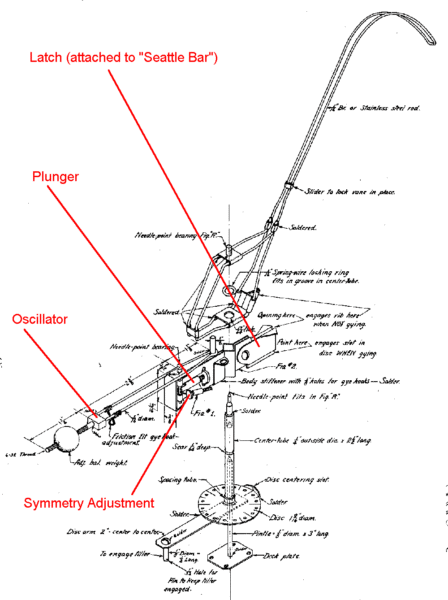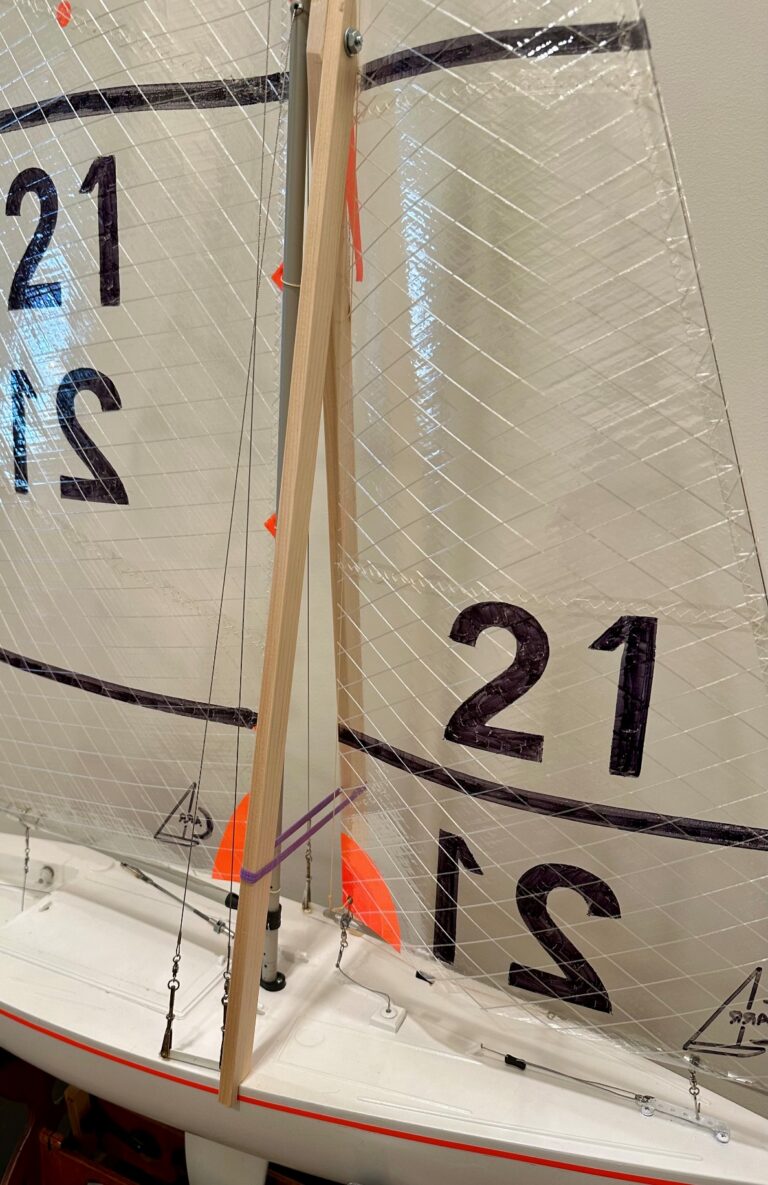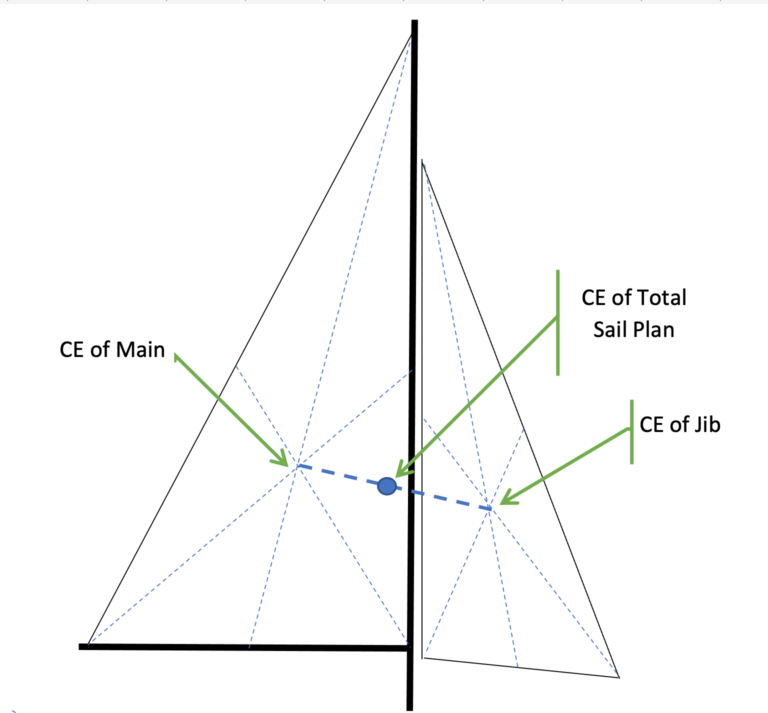by A. R. Lassell
On Sailing with Vane and Sliding Rig

We assume that your model yacht is equipped with vane steering gear and sliding rig, on which the sheets are rove [threaded — Ed.] so that one bowser simultaneously controls the set of the two sails. That bowser has been called the “Synchronous Bowser.” The standing parts of the sheets are sliding with the rig and are attached to either a jamming ring or an adjustment bowser. The main sheet is single-rove, but the jib-sheet is double-rove through a fairleader approximately half the distance to its jib-tack swivel as compared with the corresponding elements of the main sail, which results in both the boom and the club maintaining about the same angular speed as the synchronous bowser is being moved.
The major axis of the pond is assumed to be parallel to the wind, and that we experience a beat to windward at the onset of our adventure in sailing. So, we proceed to set the yacht to sail close-hauled.
Our immediate attention is to set the two sails in a definite relation to each other. The ever-present measuring means, finger-breadth, is used so as to improve on mere guessing. We haul in on the synchronous bowser snug, bringing the boom in about midships, and ease up on the jib sheet adjustment so that there is a space equal to three fingerbreadths between the mast and the clew of the jib, in the case of an “M;” for a “X,” four units and for an “A” more commeasurably with the length of its club. This set would be suitable for a 14-mile wind; in stronger winds, haul the synchronous bowser tight, not just snug. In lighter winds, ease up on the bowser in steps corresponding to the gradual decrease so, that in drifting zephyrs, the bowser has moved an inch from its original place.
If the yacht would then be picked up and headed into the wind, the sails should begin to luff at the same time. Preferably, the jib should luff before the main, and, particularly, its upper corner, the head, should have its belly deflated in the first stage of luffing. To maintain that deflation is the ideal of steering; it is the consummation of the skills in design and yachtsmanship; it is the best possible index of your proficiency. Watch that index!
A parallel aboard a full-rigged ship, as a guide for the helmsman, is the action of the wind at the weather corner of the mizzen royal (the topmost sail on the aftmost mast). The yards are braced around in a high-pitched spiral, so that the higher the sail, the earlier it luffs upon the ship heading into the wind. The helmsman keeps that corner deflated, no more, no less, and days on end, in the South-East Tradewinds, where the winds are constant.
Not blessed with such winds on our ponds, we have to put up with up-drafts and down-drafts. To preserve his assurance, the skipper must evaluate the vagaries of a down-draft realistically. If such a jet is being funneled down to the surface of the pond, it ruffles up and darkens the pond’s surface, and fans out. Thus if two yachts are sailing in the same lane but some feet apart [and] encounter such a [flow] centering between them, the leader will head up and the other will pay off with reference to the course sailed the moment before. So, that [incident] was just one of those things, and there is no need for new sails, fuller garboards, smaller skeg, or larger rudder.

The next thing to come to our attention is the sliding rig. It is an adjunct to the vane steering gear, which, by no means, all-sufficient. The rig is set to correspond to the lightest wind on the windward board [lap — Ed.] With an increase in the wind, the rig is moved ahead, and the spaces traversed in sympathy with the wind resemble the D-scale of a slide rule [i.e., decrease logarithmic scale — Ed.] The seven-inch scope allotted is rarely enough, the idea being that went the forward end has been reached, it is time to reduce the main sail. Should the rig lack scope in the aftermost position, lee helm must be used, but such an expediency is only justified to [compensate for] this limited deficiency. Lack of scope in the foremost position calls for stepping the jib farther ahead, or, as a last resort, for the sheeting in on this sail for the purpose of tipping the center of effort ahead; in other words: “choking her to death.” However, the sensible thing to do would be to start reefing the main. Equally sensible, perhaps, would be the striking of the jib instead of using lee helm in a drifting match.
The sliding rig affords a quick means of “tuning up,” and re-tuning to conform to the wind changes. The skipper should develop a built in aerometer [wind speed indicator — Ed.] behind his eyes; it gives him assurance. If the jib, by shaking too frequently, announces that the yacht is trying to lie to close to the wind, slide the rig ahead half an inch or so; if it stays “asleep,” slide the rig aft until an occasional deflation takes place.
As our system of sailing has been outlined, it differs from the usual “toy boat sailing” in as much as in this case the jib sheeted so as to tip the center of effort either ahead or aft. This system, although having limited merit, fails when the strength of of the wind requires sheeting the jib flat amidships and, often, easing up on the main. The spectacle, here, is an excessive heel, no snap, and an inordinate induced drag caused by side-slipping.

Next the vane has to be set. The self-tacking gear is assumed. It has five “triggers:” the Locking Latch, the Plunger, the Symmetry Adjustment, the Cams, and the Tension Slide on the oscillator arm. [All parts mentioned in this essay are marked on the accompanying illustration — Ed.]
The latch either locks the “Seattle Bar” (the combined friction clutch and oscillator bracket) to the vane-disc or to the vane-frame. The latch, down and locked to the disc, aligns the Seattle Bar ideally with the center-plane of the yacht and allows the flip-flop of the feather assembly, sot that the leading edge of the feather may look into the wind’s eye over either bow without manual intervention. This ability of the gear to set itself as the yacht is tacked justifies the designation, self-tacking vane.
The latch, hinged up and straddling the lug on the feather frame, locks the latter to the Seattle Bar, which, through its friction clutch, transmits the torque from the feather to the vane-arm. That expediency is used in sailing all courses other than lying close; even preferable in sailing full and by. [On a broad reach, that is, across the wind — Ed.]
The latch, hinged up without straddling the lug, is used in effecting a “quick gye.” In a gye, the yacht heaves about without direct help from her handlers. The procedure is to raise the latch, before turning the yacht about, so that the flip flop of the feather is impeded in its full-amplitude travel, then the yacht is put about low in the wind so that she may gain momentum ample for the maneuver. The quick or short guy will give the yacht eight or ten feet of offing, which may enable the yacht to fetch the finishing line without sailing the width of the pond.
In the middle of the Seattle Bar, there is a screw adjustment that actuates the Plunger. The purpose of it is [to provide] a means of controlling the angular scope in the two and from movement of the feather frame. At its widest amplitude, the angle is a bit less than 45 degrees on each side of center. Since the apparent wind over the deck has a lesser angle of incidence, the wide amplitude set produces weather helm normally. That’s how it should be, for the need of weather helm means that the center of effort is aft enough to allow the yacht to coast through a dead spot with a reduced chance of yawing (wandering off to leeward). In this situation: no wind and therefore no torque on the tiller; none need since the center of effort takes over the steering.
In order to produce less weather helm, neutral- and finally, lee-helm, the plunger is moved out by backing up on the adjustment screw. If the winds over our ponds were as constant as the South-East Tradewinds, neutral helm would be the thing, and lee helm sailing would the additional charm of a way of cheating the sail-area limitation, for the feather, then, would be acting as an unmeasured mizzen sail. When the center of effort is too far forward, lee helm must be used to make the yacht head up. In the absence of steerage way, the yacht can’t head up; the misplaced center of effort takes charge, and she yaws. The vane given control again, she slams into the wind and completes the cycle of aberration by losing steerage once more.
Not much is known of a recommendable minimum angle of setting the vane in close-hauled sailing. However, one certain yacht, using lee helm at a 30 degree vane setting, always lost her race as she paid off in an updraft, while her competitor held her course. Another one, with extreme lee helm (11 degrees), in similar situation, failed to get back on her course for lack of space. Prudence, therefore, would suggest a 3-point (33 degree) minimum.
The symmetry adjustment is provided as a means of making the yacht point equally on both tacks. The sure way of gauging this equality is by observing the lifting of the jib. “Lifting” is the sea-going expression for the deflation mentioned before. The procedure is: if she is sailing low on the wind while on the starboard tack, as compared with lying on port, turn the adjustment screw left-handedly; low on port, righthandedly. Two turns, if the difference is obvious.
After we have achieved symmetry, occasion might arise when a lopsidedness is desirable. Ability to point higher on one tack than the other is brought about by means of the proper Cam, [Check the caption under the drawing on the issue of the Cams — Ed.] on the plunger, being rotated so as to restrict the amplitude of the oscillator to leeward of the outbound tack. Used for gying; particularly, in slowing up the quick gye. Its efficacy, limited.
The Tension Slide on the oscillator functions as a means of attaching one end of one or more rubber bands and of adjusting the tension of these so that, when the inertia of the counterweight becomes disturbed, the elasticity of the rubber causes the yacht to heave about. A heading puff, a wave, or a “dead spot” can be the triggering agent. In the use of this “long gye,” there is always an element of suspense, and the skipper who converts 100 per cent is a wizard. But such wizardry is not dependent on the skipper alone; the yacht has to be designed for it, but MYRAA does not permit recessive leading edges of keels. [Lassel here is referring to the “non-prognathous” keel clause of the M Class rules, which forbade any lower part of the keel being ahead of any upper part. In his experiments, Lassel had devised what he called the “finless fin keel,” (see the illustration in the history section) which was much more maneuverable than the traditional fin and skeg mandated by the rules. The restriction was lifted by the AMYA, but is part of the Vintage M Class rules.]
We assume now that the windward passage has been made. The return trip will be done with the latch straddling the locking lug, and with the resulting locked complex rotated so that the leading edge of the feather looks into the wind’s eye 180 degrees from the position that brought the yacht to windward. That generalization does not pertain if the yacht had been tacked, for the new position would be 180 degrees from the [median] of the tacking positions, namely, directly or nearly above the vane-arm. Neither does it pertain to exactitude of any course to be steered, for an “over trim” is needed, and this depends on the yacht’s behavior characteristics in variations of the wind strength. As a rule, the stronger the wind, the more over trim.
The vane-disc is calibrated like a compass card. The total number of marks or points is 32; eight to a quadrant. For our purpose, the quadrants must be named, and the designations might just as well be derived from the general course sailed when the latch is over the quadrant. Thus, the latch over the port forward quadrant would be: Port Broad Reach. To this should be added the number of points, counted from the forward center of the disc. As an example: five points, port broad reach. Under certain wind conditions, that would be the setting for a return trip after the yacht had fetched the turning line while lying close on port tack and without having tacked. Four of these points represent the ideal 180 degrees, and the fifth, the over trim.
The term “on the port tack” means that, if the mainsail were a square sail, it would be necessary to hold down the lower weather corner by means of a tackle on the port bulwarks, when the wind was coming over the port bow. In our specific situation, the boom would be over the starboard counter, and the latch of he vane, theoretically or actually, over [the] “Starboard Close Reach” quadrant. A theoretical 3 1/2 points for close hauled, if the latch were down in the recess; actual 4 points for full and by, and 4 to eight points for close reach, with the latch up.
The sailing at certain angles with the wind, other than lying close, we shall call “sailing courses,” and forget that the term connotes compass courses. For the sake of preserving his poise, the skipper should know how to sail, both in light and heavy going, certain fundamental courses like full and by, wind abeam, the reverse of lying close, and directly before the wind.
For instance, he can expect to have set the vane at 6 1/2 points, close reach, to sail wind abeam in light airs, while 8 points would be indicated in a 20-mile wind. Directly before the wind, if the boom is out on starboard side, one or two points on port broad reach would be the setting. In this case, the kicking strap on the boom should be hooked over to starboard to prevent unauthorized jibing. Should she jibe, her new course would be at least three points off he attempted course.
How are the sails to be set? So that the sails don’t spill the wind, on the yacht getting two points off her course. That, on broad reaching and running. If the skipper must gamble, a full spinnaker gives him that opportunity, otherwise, a flat one is suggested, for it is easier to keep filled.
In order to correct the steering on the leeward board, “Squeeze her to you” is a simple rule to follow. “Her” refers to the feather-bar complex, and “squeeze” to its rotation toward the lee shore and “too you,” in an assumed position abaft the vane. A squeeze amounting to one point is rarely enough, even if the angle of approach was sharp; it is supposed to be a result of the venturi-effect.
The writer was commissioned to write concise instructions without using salty terms. Conciseness does not mean brevity, but implies an unadorned treatment of important points. All arts and sciences have their own terminologies; yachtsmanship can’t get along without its.



